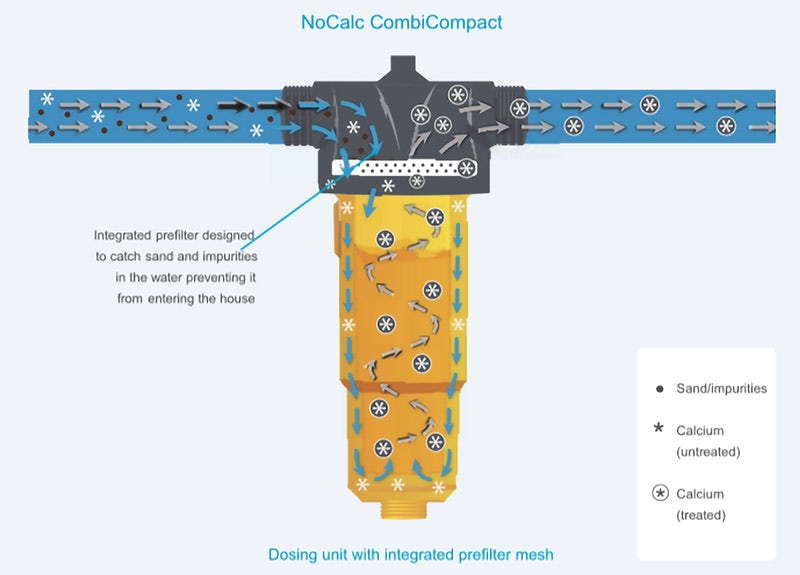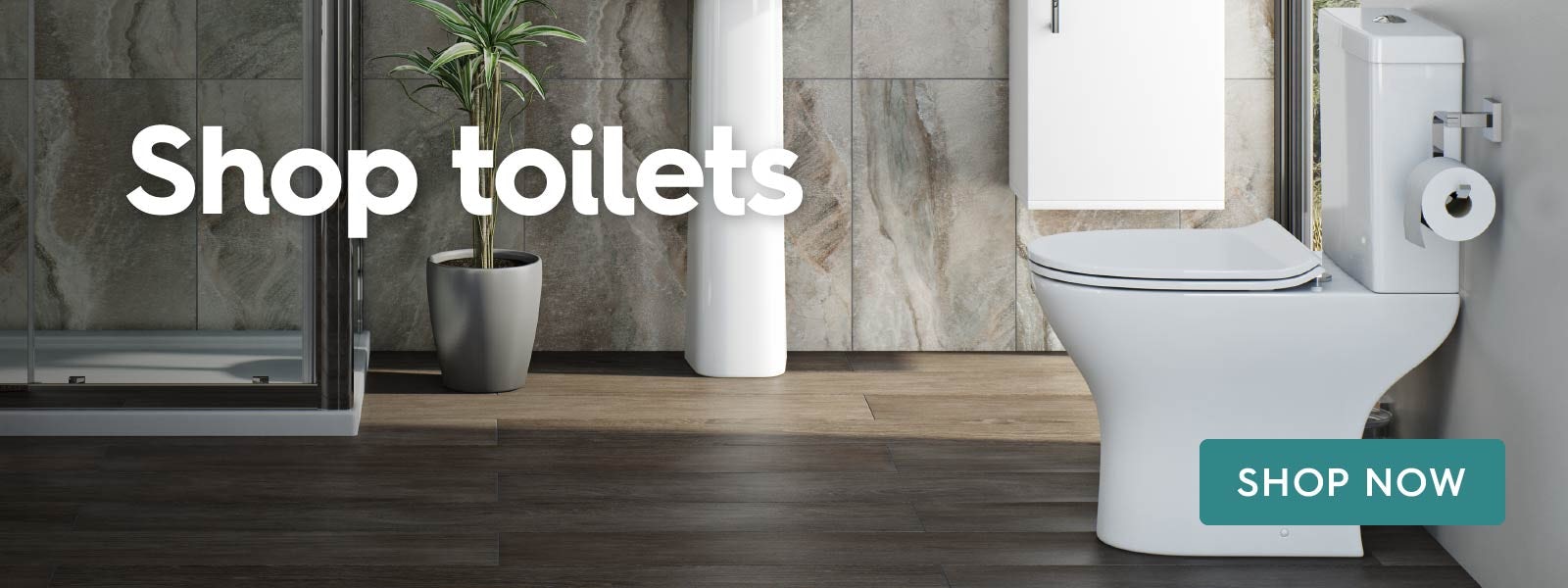Limescale build-up can leave your toilet looking terrible. So, how can you get rid of it? We explore all your options…
It’s unavoidable. Over time, limescale will build up in your toilet bowl and other parts of your home and you will need to find a way to remove it. There are countless bleach products and toilet cleaners available that promise to remove limescale and leave your bathroom looking spotless. But what is the best way to get the job done?
We try to answer that question in our guide on how to remove limescale from toilets, giving you some helpful cleaning tips so you can decide which cleaning method is the best option for your home.
What is limescale?
The hard chalky substance that builds up around the home in bathroom and kitchens is called limescale. When soluble calcium bicarbonate converts into insoluble calcium carbonate it then becomes limescale. You will spot the substance around taps, toilet bowls, baths, pipes and any water area you come into contact with on a daily basis.
When hard water evaporates calcium and magnesium combine to form limescale. This is because hard water has a high mineral content, and after it evaporates calcium and magnesium deposits are left behind on the surface.
Around 60% of the UK landmass is considered a “hard water” area, covering many of the biggest population centres like London, Birmingham, Manchester, Leeds, Liverpool, Bristol, Leicester, Nottingham, Hull, Southampton and Norwich. Limescale is a particular problem in these areas. Even those who live in “soft water” areas, like Scotland, Northern Ireland, Cumbria, Devon and Cornwall, can experience problems over time, as soft water can contain calcium and magnesium.
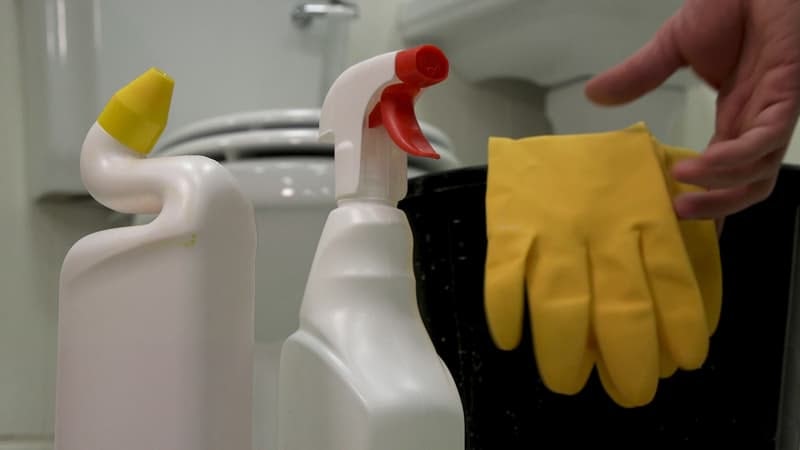
How do I get rid of limescale in my toilet?
Bleach
Commercial cleaners are based on bleach, and usually require you to use a large amount of the liquid to be effective. The best method for this type of toilet cleaner is to use them under the inside rim of the toilet as they are usually specifically designed for that job. Make sure you avoid getting any bleach on your skin – rubber gloves are always a good idea when using these sort of chemical-based cleaning products. Let it soak for about 30 minutes and then flush the toilet when finished.
Watch the video below and see our step-by-step guide to cleaning your toilet.
White vinegar
With white vinegar you have a few options. If the area you need to clean is only small, mix it together water with the vinegar (a 1:1 ratio amount is enough), and apply a spray bottle to affect the area in the toilet bowl before scrubbing it with the toilet brush.
Where there are larger sections of limescale you can simply pour the white vinegar over the entire area, making sure everything has been covered. It is a good idea to do this last thing at night so it can thoroughly soak into the limescale to erode it. When you go back, use the toilet brush to remove limescale deposits that are still present, before flushing the toilet to wash it away.
Sandpaper
Sometimes there are stubborn bits of limescale remaining on the bowl that require a little more elbow grease. Using medium-grain sandpaper to gently wear down and remove the stain is a possibility, although we wouldn't personally recommend this method on a recently-purchased toilet as it could potentially void your guarantee, should you damage the surface. If you do choose this method, be careful not to press too hard. As before, once finished you can simply flush away the residue and clean as normal.
Pumice stone
If using a pumice stone make sure the stone and toilet are both wet while cleaning, otherwise the porcelain could be scratched. Ensure you have as much water to hand as you need and use the stone to rub at the limescale in the affected part before washing away. Again, we wouldn't recommend using this method on a recently-purchased toilet, as any damage you potentially cause could void your guarantee.
Vinegar and baking soda
Another popular method to remove limescale from your toilet is to use vinegar and baking soda. Pour about one cup of white vinegar into the toilet bowl, followed by about one cup of baking soda, then let it rest for around 10 minutes. It’s a good idea to wear gloves when using this as a toilet cleaner and to have eye protection.
Guide the brush around to ensure the toilet limescale is covered and let the solution sit for another 25 minutes before finally flushing. This should do a great job at cleaning the bowl and remove all the limescale from your toilet. Getting access to the u bend is difficult to remove limescale, but any of these methods should be enough.
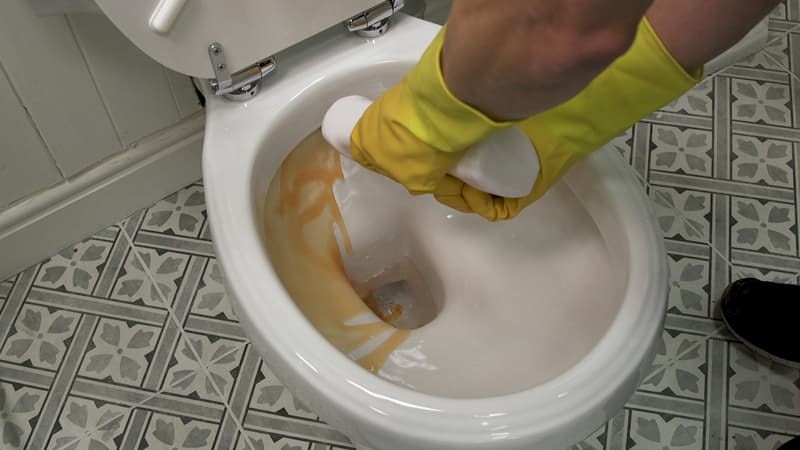
Does WD 40 remove limescale?
WD 40 is great for cleaning out keyboards or loosening bike chains – but did you also know it is really good at removing limescale from your toilet?
While it can be put to a number of helpful uses around the home, WD 40 is particularly good at softening rust and limescale deposits in the toilet (and bathroom). All you have to do is spray it on the desired section of the toilet, wait a few minutes, then scrub it away with a toilet brush.
Hard water stains can look pretty unsightly if they are not tackled, making the toilet looking dirtier than it actually is. You can also spray WD 40 in the bathroom or sink to deal with the same issue. It will get rid of hard water stains and limescale and make your toilet look much brighter.
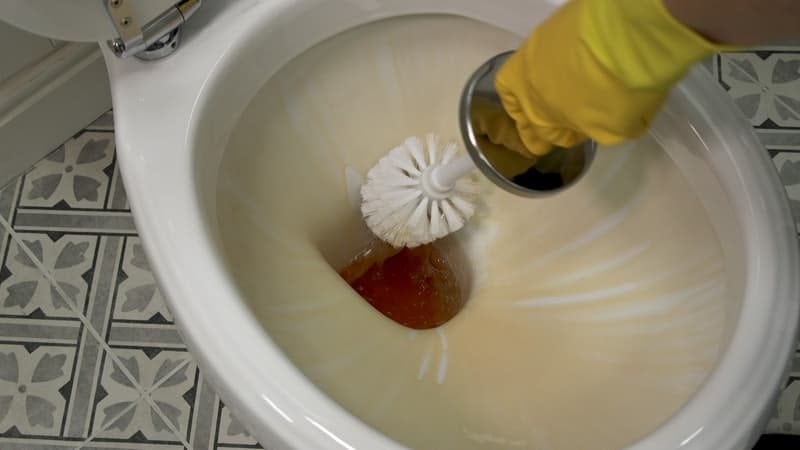
Does Coke remove limescale from toilet?
There are a few methods for removing limescale from your toilet and using Coke may seem like the most bizarre of them all. Yet, perhaps even more strangely it is also one of the methods that work.
The reason for this is due to the mild acid properties of the drink. If you are a fan of Coke you may not like the idea of taking a bottle and pouring it down the toilet, but you may be surprised at how effectively it clears away limescale stains. Follow these steps:
- Step 1: Guide the open Coke bottle around the rim of the toilet bowl, making sure it covers everywhere you need.
- Step 2: You need to give it some time to start to work as a limescale remover so let it sit in the bowl for a while.
- Step 3: Now flush the toilet and the acid in the Coke will loosen up the limescale in the toilet bowl. Most of it should then be washed away with the water flow.
- Step 4: You can repeat this process until the toilet is as clean as you want it to be.
For more stubborn limescale deposits you can scrub at the limescale with a brush before flushing. Regardless of the stage you are at, always wear rubber gloves to protect your hands from germs and wash your hands afterwards.
Lemon juice
An equally cost-effective method of removing limescale is to combine lemon juice with white vinegar. The combination of lemon juice and white vinegar as a natural cleaning agent is a far more eco-friendly method of dealing with the build-up of limescale. Calcium carbonate (its scientific name) is not able to handle the additional layer of acid found in lemon juice, which when left to soak for around an hour so it can break down and scrubbed away.
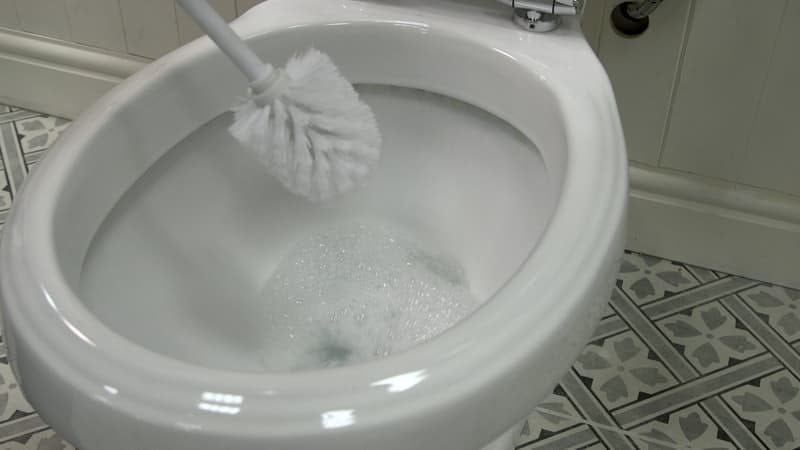
Removing limescale from other parts of the home
Bathroom fittings and taps
Using a combination of half water/half vinegar in a bottle you can spray it onto tiles, bath tubs and taps to fight against limescale. Once you have sprayed and had a good scrub down, rinse with water to clean away any remaining residue.
Build-up of limescale often occurs on taps due to hard water, but there is an easy solution for this. Soak a cloth in vinegar and wrap it around the tap overnight. This should soften up the limescale so you can scrub it away when you return. Avoid doing this on plated taps, especially gold, as this could permanently damage the finish.
Another good solution is to squeeze out the juice from a halved lemon and put each half onto a tap. You can also soak a cloth in lemon juice before wrapping it round the tap to let it soak overnight.
Kettles
It isn’t just bathrooms that have to deal with the issue of hard water. Calcium carbonate also builds up on inside surfaces of appliances such as kettles and coffee machines as they come into contact with water on a daily basis.
To remove limescale from these surfaces you can fill the kettle with a combination of half water and half vinegar and let it soak overnight. When you come back to it the following the morning the limescale should come off quite easily. The smell of vinegar can be quite strong so be sure to rinse it off thoroughly, so no odours linger on.
Coffee machines
When it comes to coffee makers, pour the vinegar solution into the water section. Then turn it on to go through the usual process—without any coffee inside. Then repeat this a couple of times using plain water and the limescale should be easy to remove.
Washing machines
Limescale build up also occurs in washing machines and there are some straightforward methods to tackle this. To remove limescale from a washing machine pour a large cup of lemon juice or vinegar in the same place you would normally put the detergent. Turn on a normal wash cycle to run the machine empty and this should clear away the limescale.
Dishwashers
When it comes to a dishwasher, pour either lemon juice or vinegar into the base of the machine, then run it on empty using a normal cleaning cycle. This will not only remove the limescale but add a nice fresh smell inside too.
Showerheads
Along with taps, showerheads are another fixture that have to deal with limescale build-up. To remove limescale from a shower head, soak it in a solution of half water and half white vinegar overnight. When you return in the morning you can rinse the showerhead with water and also use a pin to push out any remaining limescale that may be in the jet holes.
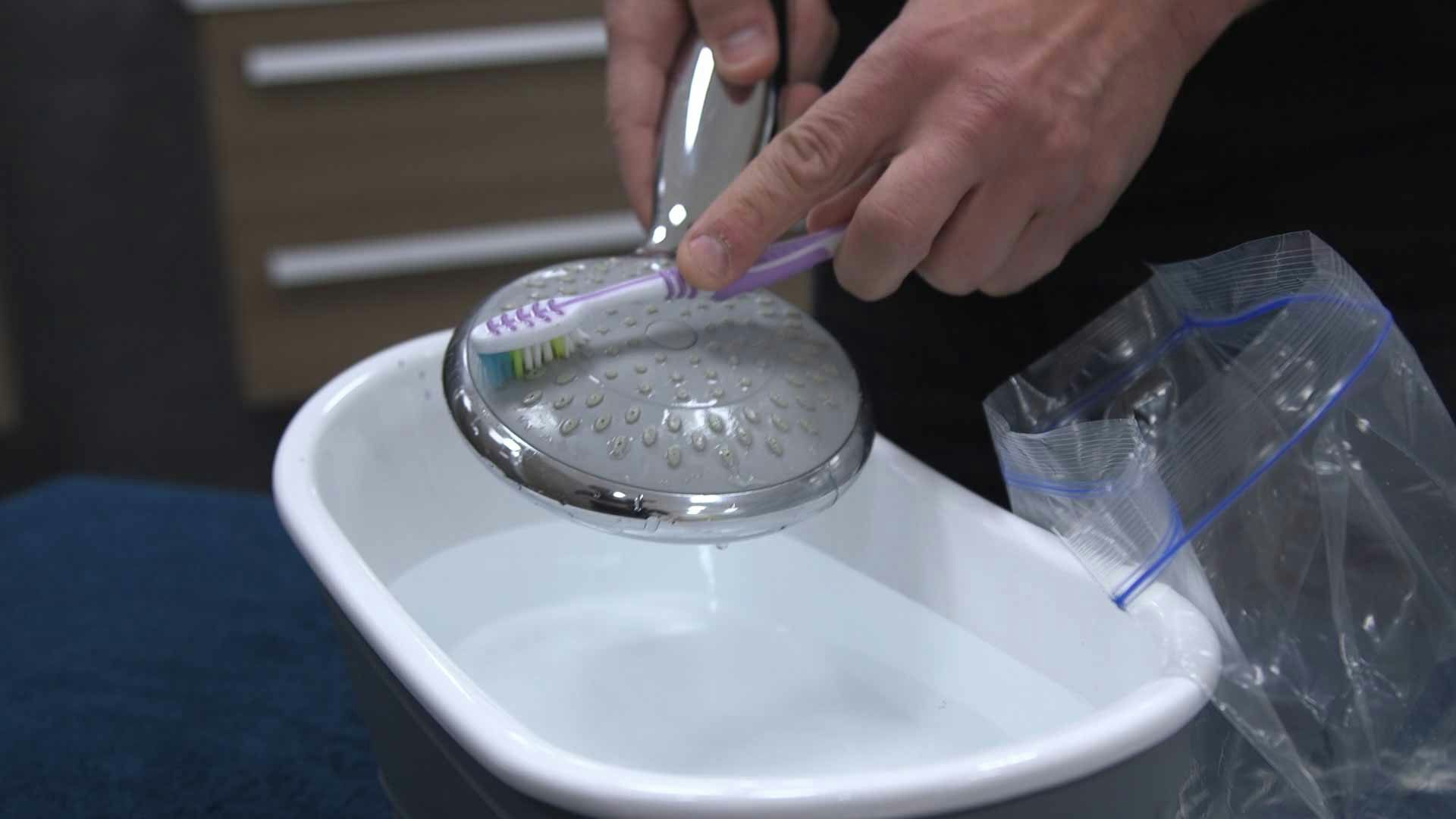
Shower screens
A 1:1 ratio of white vinegar and water can be applied to give your shower screen its sparkle back. Use an old toothbrush to remove any initial grime, before spraying the solution onto the screen. Leave it to soak for 30 minutes and return to rinse.
Water pipes
Because limescale is naturally in the water, it also builds up on the water pipes it passes through. A combination of white vinegar and baking soda is good for this and can be poured directly down the drain. Leave it to settle for a few hours and pour boiling water down the drain when rinsing.
Kitchen and bathroom tiles
Limescale removal is also something that needs to be done on bathroom and kitchen tiles as water often splashes onto these surfaces. Use a spray bottle that is half vinegar and half water and spray this onto the area. Leave it for a few minutes and it should come off quite easily.
How to remove limescale from tap water
There are plenty of methods to remove toilet limescale in other parts of the home, but how can you remove limescale from water?
- Using a water softener can help, with calcium and magnesium removed by a process called ion-exchange.
- Reverse Osmosis relies on a perforated membrane to block chemicals and the likes of calcium, lead and magnesium. This means any volatile chemicals are not present in the water when you drink it.
- Scale inhibition filters are filtration systems that are used to keep the home clean from limescale. They are usually electronic devices attached to pipes in the home that work to reduce the build-up of limescale over time.
Like this article?
If you’ve enjoyed this article, you’ll find plenty of handy tips and advice on cleaning your home right here at Victoria Plum. Simply head to our bathroom advice centre and search for “cleaning” or check out some of the articles below.
- How to clean a toilet
- How to clean tiles
- How to clean a shower screen
- Spring cleaning: Breathe new life into your bathroom
- 5 ways to turbo charge your bathroom clean by Ideal Standard
- Our top 10 home care hacks
- Protect your bathroom with revolutionary Showerguard
Shop toilets
Has limescale build-up left your toilet looking old before its time? If none of the cleaning tips we’ve suggested in this article are doing the job, perhaps it’s time for a change? Browse our huge selection of stylish toilets, with eco-friendly options, plus rimless designs to help keep things nice and clean. Simply click on the image below to begin browsing.

